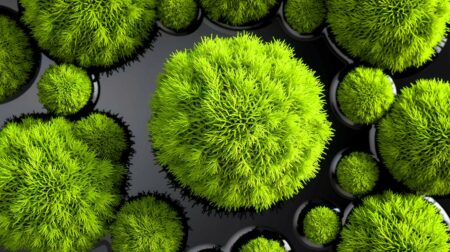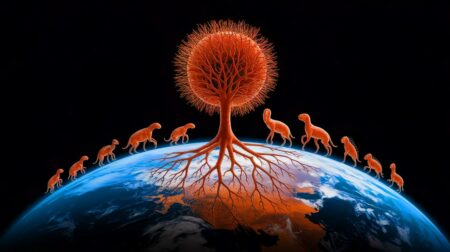| IN A NUTSHELL |
|
In a groundbreaking revelation, Japanese researchers have unveiled a fascinating aspect of Earth’s ancient past—our planet’s oceans might not have always been the deep blue we know today. Instead, they were potentially a vibrant green, influenced by the chemical makeup of the water during the Archaean eon. This finding not only redefines our understanding of Earth’s early environment but also offers a glimpse into how primitive life forms might have thrived in such unique conditions. As we delve deeper into this discovery, it becomes evident how the interplay of elements shaped the very origins of life on our planet.
The Ocean Wasn’t Always Blue
An intriguing study published in Nature has shed light on the water chemistry of Earth’s oceans during the Archaean eon, a critical period in our planet’s evolution approximately 3.8 to 1.8 billion years ago. During this epoch, the Earth’s atmosphere and oceans lacked the gaseous oxygen that is essential for most life forms today. Back then, life was primarily limited to single-cell organisms residing in the oceans.
The levels of iron in these ancient waters were significantly higher, and the organisms of the time were just beginning to harness energy from sunlight through anaerobic photosynthesis. This process, devoid of oxygen, eventually led to the “Great Oxidation Event,” marking the dawn of complex life on Earth. The study highlights how the unique chemistry of the ocean at that time, particularly the abundance of iron, allowed blue-green algae to flourish, giving the waters a green hue.
Miracle Down Under: Australian Patient Walks Free with Artificial Heart After 100+ Days
These algae, known as cyanobacteria, played a pivotal role as they were among the first organisms to perform photosynthesis using ferrous iron. This process resulted in the production of oxygen, gradually transforming the atmosphere and paving the way for more complex life forms. The presence of an accessory pigment, phycoerythrobilin (PEB), in these organisms suggests they thrived in greener waters, further supporting the notion of ancient green oceans.
Japanese Research Unveils Ocean’s Verdant Past
Japanese scientists from Nagoya University have made a compelling link between the color of the ocean and water chemistry eons ago. Observations around Iwo Jima, a volcanic island in Japan, revealed green-hued waters rich in oxidized iron, known as Fe(III). This environment supports abundant growth of blue-green algae, prompting researchers to consider the conditions of ancient oceans.
Three-tonne fuel savings per day: This revolutionary winged cargo ship sets a new maritime standard
In these iron-rich waters, early aquatic organisms relied on iron to fuel photosynthesis, as oxygen was absent in the oceans of that era. By genetically engineering blue-green algae to contain PEB, researchers demonstrated their enhanced growth in green waters. Computational simulations further supported that oxygen release would have oxidized enough iron to turn ocean surfaces green.
This study not only illuminates the past but also opens possibilities for understanding how life might evolve under different planetary conditions. The insights gained from this research could inform future explorations of life-sustaining conditions on other planets, providing clues about where to look for signs of life beyond Earth.
Scientists create heat-resistant super corals that could save entire marine ecosystems from collapse
Will the Ocean Turn Purple?
As research into Earth’s ancient oceans progresses, intriguing theories about the future of our planet’s waters emerge. A study from Cornell University speculates that as the sun ages and becomes brighter, the Earth’s oceans could potentially change colors again, possibly turning purple. This transformative theory suggests that the interplay of sunlight and water chemistry could lead to dramatic shifts in oceanic hues.
The Conversation notes that such changes might occur over vast timescales, with the eventual evaporation of oceans as the sun engulfs the Earth. The notion of changing ocean colors, whether green, blue, or even purple, invites us to consider the dynamic nature of our planet’s environment. It emphasizes the importance of understanding these processes as we look to the skies, searching for life on other planets and considering how these findings might guide our explorations.
Implications for Astrobiology and Future Research
The discovery of ancient green oceans has far-reaching implications for astrobiology and the search for extraterrestrial life. As scientists explore the potential for life on other planets, the color of oceans could serve as an indicator of biological activity. The presence of certain pigments, like those in cyanobacteria, might signal the existence of life in environments vastly different from our own.
This research invites us to consider how life might adapt to different chemical compositions and environmental conditions. As we continue to explore our universe, understanding these variations could be crucial in identifying habitable zones and recognizing signs of life. The study of Earth’s ancient oceans provides a valuable framework for interpreting planetary conditions elsewhere, paving the way for future discoveries in space exploration.
As we reflect on the verdant past of our planet’s oceans, we are reminded of the intricate connections between chemistry, biology, and environmental conditions. This research not only enhances our understanding of Earth’s history but also inspires new questions about the future. How will our knowledge of ancient oceans influence our search for life beyond Earth, and what other secrets does our planet hold that could reshape our understanding of life itself?
Did you like it? 4.4/5 (27)









Wow, green oceans! 🌊 Never thought of that! Nature is full of surprises. 🤯